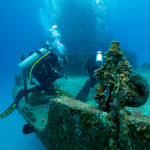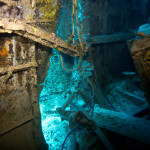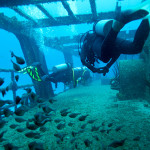Most divers who visit Cozumel go for the beautiful diving along the world’s second largest barrier reef system. The Meso-American reef system spans almost 600 miles of ocean between the Gulf of Mexico and Honduras, and Cozumel’s spectacular reef formations, sea life, and exceptionally clear waters make this island one of the world’s most popular diving destinations. Divers are able to see beautiful coral heads, colorful sponges, tropical fish, rich, healthy ecosystems and steep walls that drop to thousands of feet deep. Tunnels and caves twist through the reef, providing a safe and diverse environment for many species, including some not found anywhere else on earth. Most of diving sites in Cozumel are located within the Cozumel Reefs National Marine Park (Parque Nacional Arrecifes de Cozumel), a protected underwater environment covering 29,000+ acres.
Cozumel isn’t particularly known as a wreck diving location, and for good reason. Ships that went down in rough waters offshore sank to depths far greater than any scuba diver could visit, and wrecks in shallower waters are eventually beat into oblivion by seasonal storms and tropical hurricanes that pass through the area. Fortunately, there are a few sunken ships here that are interesting dives and worthy of a dive or two on your next visit to Cozumel. One of those wrecks is the C53 Felipe Xicotencatl.
Words & Photos by Chris Constantine, California Diver Magazine
The C-53 was originally built in Tampa in 1943 at the Wilson Marine Shipworks as a mine sweeper for service during World War II, at which time she was named the USS Scuffle. Immediately upon completion, she went into battle in the Pacific theatre. Measuring 184 feet long, 33 feet wide and 40 feet high from keel to the top of the super structure, she participated in the pre-invasion mine sweeps at Lingayen Gulf on January 6, 1945 and at Zambales and Subic Bay on January 29th and 31st. After completing the pre-invasion mine sweeps, she helped extend the cleared areas during and after the initial troop landings and provided antisubmarine and antiaircraft protection for transports. The Scuffle was later awarded a Presidential Unit Citation and five battle stars for her service at sea. At the conclusion of the war in 1946, she was decommissioned
Sinking a Ship
Sinking the C-53 as an artificial reef and dive attraction was designed and carried on by the ANOAAT (Cozumel Watersports & Tourism Association), in collaboration with local dive shops and the Parque Marino Arrecifes de Cozumel. The inspiration came from another place where ships had been successfully sunk by and for divers – Canada.
According to Eco Divers Cozumel, “This project started in 1998 at a DEMA show. We met some Canadian folks that where making artificial reefs for their diving areas by getting old boats from their government, cleaning and preparing them for sinking and diving safely, and they gave us the inspiration. Once back in Mexico, we started knocking doors to get an old, out of commition Navy boat.
During this time, the National Marine Park “Arrecifes de Cozumel” was starting, so in coordination with them as Federal Marine Authority, we started inviting all diferent groups of the community, the local authorities and of course the ANOAAT members wich is the local Dive shops association. After more than a year,the President Ernesto Zedillo authorized three boats for such a project, which now are in Veracruz, Cancun and Cozumel.”
The location chosen for the wreck is just offshore from Chankanaab Park. The site was selected for a number of reasons, including easy access for divers, in an area sheltered from stronger currents common in the area, and on a big sand bar, where the ship wouldn’t damage any of the existing reef structures.
Before sinking, the ship was carefully (and quite thoroughly) stripped of hazards that might endanger divers, including removing doors, wiring, piping, and other entanglement hazards. Potential toxins were removed and the entire boat was throughly cleaned to prevent any pollution from damaging the nearby reefs and sea life. Large holes were cut into the sides, allowing light to enter and providing safer access for divers.
Finally, on June 5, 2000, the C-53 was sent to the bottom of the ocean to her final resting place in about 80 feet of water, landing upright to a soft landing on a sand bar. Sitting perfectly upright, she has become an attraction to thousands of scuba divers and provides a new home to sea life. The C-53 has become a major attraction for divers who travel here from all over the world to experience a sunken ship with a fascinating history of saving lives for two different countries.
The C-53 is an easily accessible dive site and many local dive operators take divers out on a daily basis. While it is located just off Chankanaab Park, it’s not a shore dive due to unpredictable currents that run through the area. For my dive here, I chose an afternoon dive with Scuba Club Cozumel, leaving the dock at 3pm for a single dive on the C-53.
After a short boat ride and thorough dive briefing, we were ready to descend on the wreck. With the boat secured to the buoy, we entered the crystal-clear water and immediately saw the wreck below. As our group of 6 divers followed our Divemaster down the line, and just as briefed, we had a fairly significant current running. Descending on the wreck is quite dramatic and we were able to see almost the entire topside of the wreck immediately upon entering the water. Most divers didn’t have a problem swimming down while using the line to guide them, but it is definitely something anyone who dives here should be comfortable with. As predicted, the current subsided at depth to a comfortable, gentle movement of water that was easy to swim with or against.
Once down, we swam alongside her port side to the rear deck, where we then were able to enter inside the wreck and begin our tour inside the ship, where hundreds of World War II soldiers once scurried from station to station as they cleared minefields in the Pacific. While the hazards of loose wires, electronic equipment, and doors have been removed for safety, the character of the ship remains intact, and we were able to see crew lockers, ladders, and engine room equipment intact. A good flashlight is essential for exploring the passageways.
The C-53 has been down since 2000 – more than 15 years – and is slowly being covered by a healthy growth of sea life. Divers here will see much of the life which now calls the C-53 home, including glassy sweepers, sponges and coral which are starting to form thick colonies on the metal of the wreck. A particularly large moray eel occupies the bunk room, and will probably say hello as you swim by. You’ll also see tiny Blenny’s, starfish, and cleaner shrimp, and at the end of on our dive, a large grouper hovered just outside the top deck.

Is this a good wreck for any diver? While it doesn’t require technical diving skills or wreck diving certification, it’s not an ideal wreck for newly-certified divers or those who don’t have at least some diving experience under their weight belts. Currents here can be strong and somewhat unpredictable (especially during descent and ascent), and divers swim through an overhead environment in water up to 75 feet deep. The Divemasters who take divers here know the wreck inside out and every dive shop uses the same path through the wreck, but you’re still going to need to be very comfortable with basic scuba skills, have good buoyancy control, be mindful of air consumption, and prepared to swim through an enclosed space.
If you are interested in advanced training, several instructors and dive shops do offer wreck diving certification, using the Felipe Xicoténcatl C-53 as a training ship.
If you’re heading to Cozumel, be sure to make a dive or two on the Felipe Xicoténcatl C-53. A single guided boat dive will set you back around 1,000 pesos (about $55) and you’ll be rewarded with a fun wreck dive on a ship with a fascinating history.
• • •
If you’re headed to Cozumel anytime soon, the C-53 is a worthwhile dive and will make a memorable dive with great photo opportunities. For more information, visit one of the links below.
ScubaBoard – Diving the C-53
USS Scuffle (AM-298) – Wikipedia, the free encyclopedia
Shipwreck Dive Cozumel Island
Words & Photos by Chris Constantine, California Diver Magazine


















